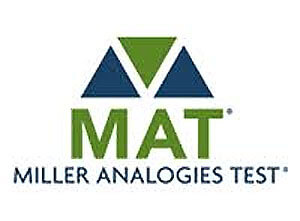 The Miller Analogies Test (MAT) is a test designed to test analytical ability, and the MAT structure is very simple and straightforward. Success on the MAT Exam demands not only strong analytical abilities, but also a knowledge of Western culture, music, literature, art, and history. Additionally, MAT test questions often require a knowledge of scientific subjects such as the natural sciences, the social sciences, and mathematics. Although the test questions consist entirely of analogy questions like those seen on the GRE and SAT, a very high score on the MAT requires more than just a strong vocabulary. The MAT exam is devised and published by Harcourt Assessment.
The Miller Analogies Test (MAT) is a test designed to test analytical ability, and the MAT structure is very simple and straightforward. Success on the MAT Exam demands not only strong analytical abilities, but also a knowledge of Western culture, music, literature, art, and history. Additionally, MAT test questions often require a knowledge of scientific subjects such as the natural sciences, the social sciences, and mathematics. Although the test questions consist entirely of analogy questions like those seen on the GRE and SAT, a very high score on the MAT requires more than just a strong vocabulary. The MAT exam is devised and published by Harcourt Assessment.
Test Content
There are 120 analogy questions on the MAT. The partial analogies given in the MAT test questions compare two sets of words, with a similar relationship existing between each of the two words. Although test takers answer a total of 120 questions, only 100 of the questions answered will actually contribute to the test taker's score. The other 20 questions are merely placed on the test as experimental questions. Data from these experimental questions may be used on new versions of the the MAT in the future. Test takers are given 60 minutes to answer all of the questions on the test.
Since the fall of 2004, the MAT has been offered as a computerized exam. Currently, the computerized form of the test is the only form available. The test is not offered in any language other than English. It is not permissible for test takers to have dictionaries, calculators, notes, or any electronic devices with them when they take the exam.
Scoring
Scores on the MAT range from between 200 and 600. Scores given on the test in this range are "scaled" scores, and a score over 500 is extremely rare. The median score on the test is 400, and this mean score has a standard deviation of 25 points. Test takers receive not only scores, but they also receive percentile rankings to show how well they have scored in comparison to other test takers. Those who take the test can get not only a percentile rank in general, but also a percentile rank for those accepted to the graduate school at which they want to study. In addition to being used in graduate school admissions, the MAT is also used to determine eligibility for Mensa and the Prometheus Society.
Value of Results
Studies have shown the MAT exam to be an accurate predictor of success in work and in academia. Meta-analytic study data, compiled by Kuncel and colleagues, has shown that MAT scores measure aptitude in the same way that many cognitive ability instruments, such as the GRE and school grade point average, do.
Individuals interested in applying to graduate school may be interested in taking the MAT. Also, those who are interested in being accepted into organizations such as MENSA might be interested in the exam. MAT structure is much simpler than the structure of other tests like the GRE, and preparing for the exam is therefore a very straightforward process.